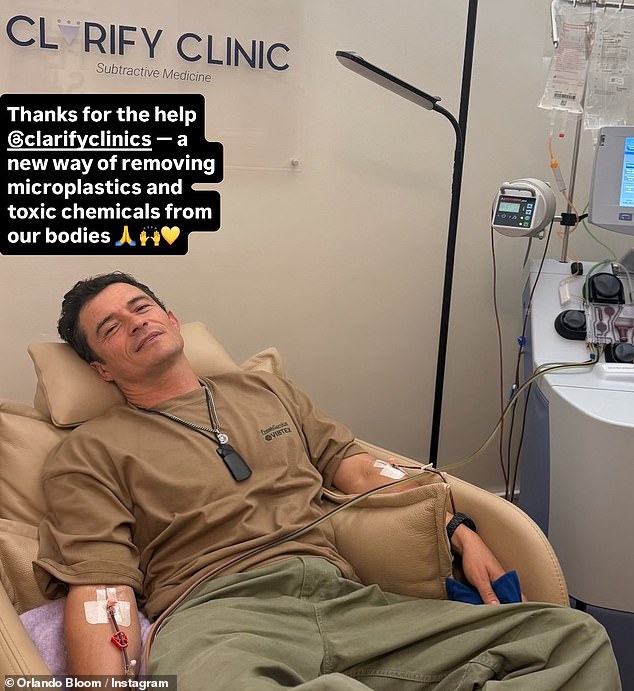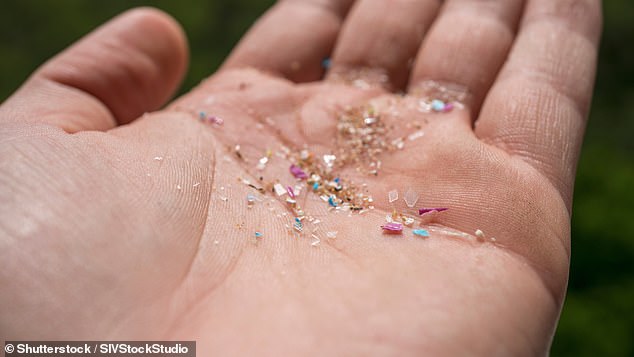It’s a wellness obsession that has hooked Hollywood A-listers and longevity gurus alike—getting rid of microplastics in the body.
The particles—which have been linked to cancer—have been found in human blood, semen, lungs, breast milk, bone marrow, placenta, testicles and even the brain.
Scientists have also discovered traces of the tiny plastics fragments, measuring less than 5mm, everywhere from the ice in Antarctica to the summit of Mount Everest.
But when actor Orlando Bloom, 48, was pictured having a £10,000 treatment last month to remove microplastics from his blood, it thrust the subject back into the spotlight.
The 48-year-old, who once wrote that his morning routine involved having ‘brain octane oil’ for breakfast and 20 minutes of Buddhist chanting, praised the London clinic’s two-hour treatment.
Bloom, who starred in film franchises like Lord of the Rings and Pirates of the Caribbean, hailed it as a ‘new way of removing microplastics and toxic chemicals from our bodies’.
However, dozens of experts have since expressed scepticism regarding the claims of Clarify Clinic’s, arguing that the basement clinic just off Harley Street, has little ‘reliable evidence’ for how effective the procedure is.
Fresh research, however, has now suggested there may other anti-aging benefits to the method, known medically as a blood plasma exchange.

Orlando Bloom, 48, underwent a £10k treatment to remove microplastics and toxic chemicals from his blood at Clarify Clinic last month

Bloom, who starred in film franchises like Lord of the Rings and Pirates of the Caribbean, hailed it as a ‘new way of removing microplastics and toxic chemicals from our bodies’. Pictured, with ex-fiancé Katy Perry
So what is the truth? And should we really be worried about microplastics in the blood?
A blood plasma exchange works by extracting blood from the arm, where it is then separated into its different components, red blood cells and plasma.
Plasma is the pale yellow liquid that carries blood cells, proteins, and other substances throughout the body.
This plasma is cleansed of ‘forever chemicals, microplastics, inflammation and the poisons and toxins’, according to Clarify Clinic’s co-founder David Cohen, before it is put back in the body with the red blood cells.
This is similar, in principle, to an approach used by the NHS to treat conditions such as myeloma, multiple sclerosis and some types of leukaemia to remove abnormal proteins and harmful substances from the blood.
But like all medical procedures it carries potential risks.
Common side effects can include nausea, fatigue and dizziness. More serious, although rare reactions include infections from bacterial contamination and patients can also suffer electrolyte imbalances that can make them ill.
For this reason, the benefits of the procedure are believed to only outweigh the risks for life-threatening medical conditions.

Invisible to the human eye, microplastics are tiny plastic fragments as small as two micrometres, or two-thousandths of a millimetre
Additionally, using the technique as form of blood-washing for microplastics has not been tested in randomised trials.
Professor Edzard Ernst, a world-renowned expert in complementary medicine at the University of Exeter, said: ‘I am not aware of reliable evidence showing that the procedure has any of the claimed effects on human health.
‘I am not even sure that it removes anything from the patient other than a lot of cash.’
British medic Dr Michael Mrozinski, who boasts over 94,000 followers on Instagram account where he calls out ‘medical misinformation’ also took aim at the practice.
‘Orlando Bloom paid thousands for a “microplastic detox” where his blood was filtered through plastic tubing, using plastic cannulas, into a plastic machine, to remove microplastics,’ he said.
‘You couldn’t script this better if you tried. The wellness industry has officially eaten itself.’
Dr Dan Baumgardt, a GP and senior lecturer in the school of physiology, pharmacology and neuroscience at the University of Bristol, also told The Times: ‘Any procedure requiring intravenous cannulation and separation of blood constituents is not going to be risk-free.
‘Simple cannulation carries a risk of infection, haematoma and extravasation [the leakage of fluid from a vein into the surrounding tissue], and with any procedure it’s important that the risks don’t outweigh the intended benefits.’

Experts say you can cut your exposure to microplastics by swapping out plastics in your home for natural materials, metal and glass
A spokesperson for Clarify Clinic said: ‘The biological plausibility of removing synthetic particles from circulation, and their known contributions to inflammation and toxicity, provides a clear scientific rationale.’
No larger clinical trials assessing blood plasma exchange impact on microplastics, specifically, have yet been carried out.
One recent trial, however, has found it could slow biological ageing.
The small study of 42 participants, discovered that those who underwent the treatment over the course of a few months had lower concentrations of biological compounds that accumulate with age, compared with a control group.
This essentially means they were ageing more slowly, keeping their biological age lower.
Writing in the journal Aging Cell, US researchers said: this is the first study in humans to report a decrease in biological age by blood plasma exchange using well-validated epigenetic metrics of biological age.’
The trial, however, was sponsored by Circulate Health, a plasma exchange startup.
Although wary of the idea of microplastic blood detoxing, experts have repeatedly raised the alarm over people’s increased exposure to microplastics.
Invisible to the human eye, microplastics are tiny plastic fragments as small as two micrometres, or two-thousandths of a millimetre.
These particles make their way into food, water supplies and even into the air as plastic products degrade over time.
Studies have suggested that they could lodge in sensitive blood vessels and trigger heart attacks, or cause Alzheimer’s disease if they get in the brain.
However, other experts have argued scientists are still not measuring microplastic levels correctly.
In a commentary published in the journal Nature earlier this year, four scientists said human tissue samples may be being contaminated from the plastic test tubes and dishes used in laboratories.
‘Modern laboratories are hot spots of microplastic pollution,’ they added.












